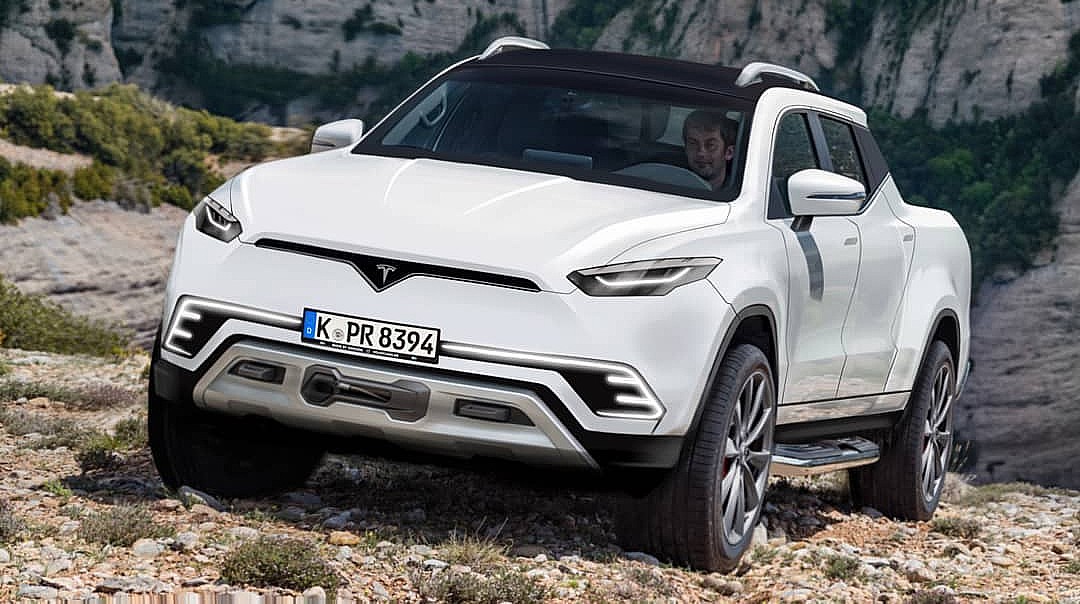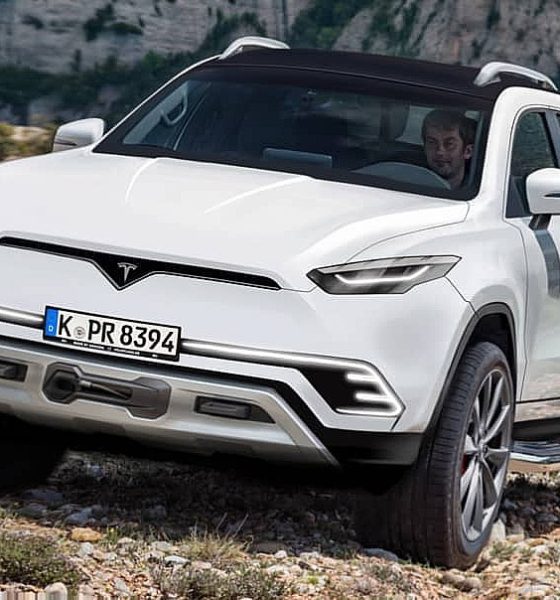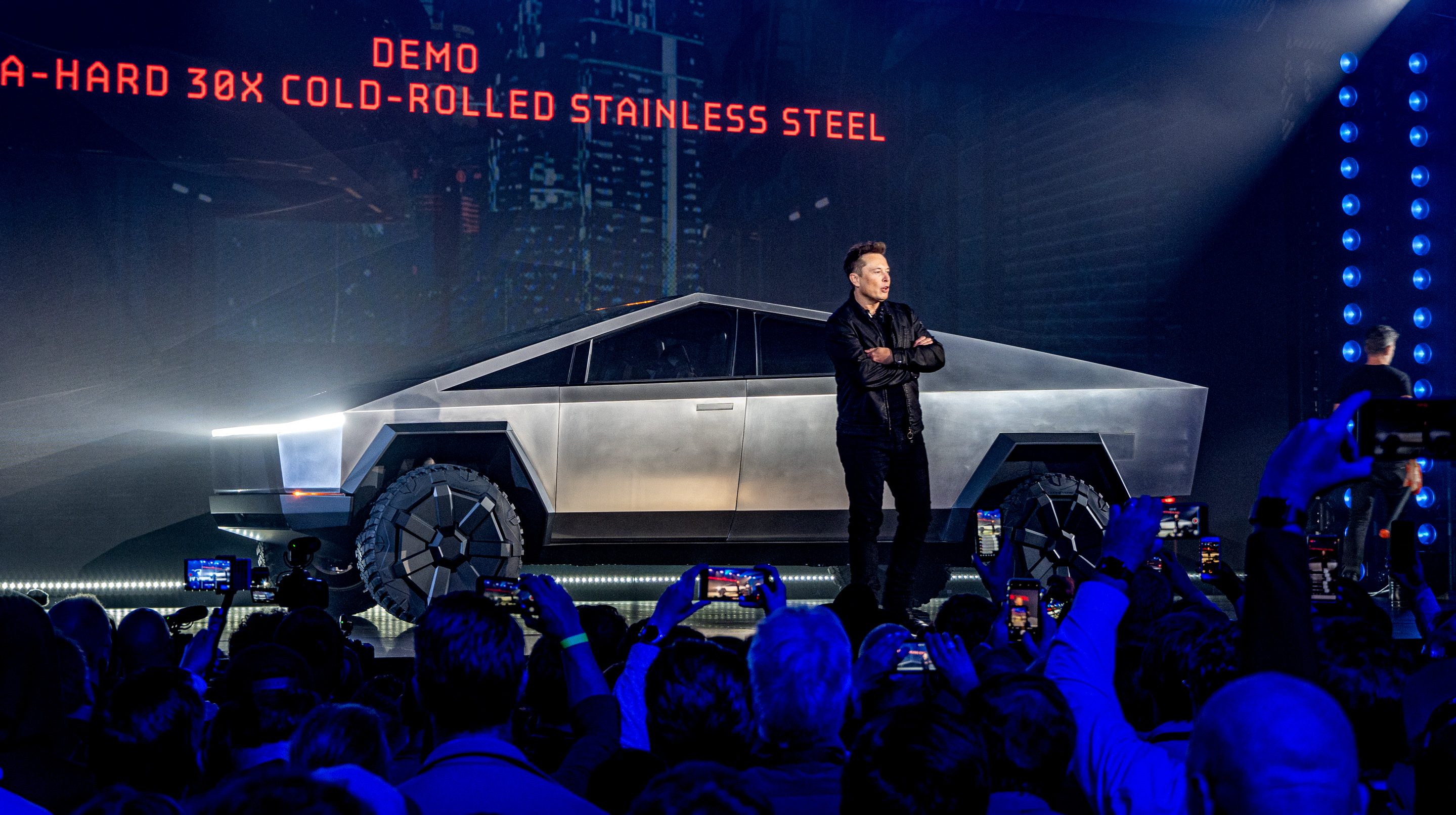

News
Tesla has a backup plan for the Cybertruck, but don’t plan on seeing it
Tesla CEO Elon Musk indicated that if the company’s Cybertruck tanks in terms of sales, the electric automaker will design and manufacture a “normal” truck with a typical pickup design, but don’t bank on seeing it.
Tesla unveiled its Cybertruck in November 2019, and its design was met with both support and criticisms from automotive enthusiasts. Nobody had ever seen anything like it before: a stainless steel exoskeleton, wrapped over a futuristic and robust frame, powered by a series of electric motors that would give it impressive and useful capability on and off of the road.
Despite the truck’s unique design, it has accrued a massive amount of pre-orders and has caught the attention of many people around the world. Even though Tesla is prepared to design a new, “normal” pickup for those who would like sustainability while hauling, don’t hold your breath on seeing it.

During a recent interview with Automotive News, Elon Musk stated that Tesla was prepared to deal with slumping sales when the Cybertruck is released in late 2021. There is a possibility that the company’s first pickup will not do well, and Musk said that Tesla would adapt.
“If it turns out nobody wants to buy a weird-looking truck, we’ll build a normal truck, no problem,” the Tesla CEO said on the Daily Drive Podcast. “There’s lots of normal trucks out there that look pretty much the same. You can hardly tell the difference. And sure, we could just do some copycat truck. That’s easy. So that’s our fallback strategy.”
Reports from various media outlets, along with a Cybertruck reservation decoder, had estimated that the company’s pickup was pre-ordered over half a million times by the time February had arrived. The most recent update from the Cybertruck Owner’s Club came in late May, and the site had indicated over 713,000 total pre-orders for the truck so far.
One Cybertruck reservation holder who has pre-ordered two Tri-Motor configurations told Teslarati that the second reservation number indicated they were the 792,302 truck ordered. “On 6/15, I put in my 2nd Cybertruck reservation. According to the Cybertruckownersclub.com reservation decoder, that makes me #792,302.”
Although the prospective number of reservations is somewhat astronomical, that isn’t stopping Tesla from preparing for the worst. A back-up plan will be developed to be safe.
Interestingly enough, one of the first segments of the Cybertruck’s unveiling event last Winter started with a comparison of the currently-available pickup trucks that roam on streets in the United States. All trucks will have a cab and a bed, but the design of pickup trucks across manufacturers remains the same on a relative scale. There is very little individualism between vehicle designs. Without badges, it isn’t easy to decipher which car company is making each truck.
Tesla’s goal with the Cybertruck was to create something the world had never seen before. People hadn’t ever seen any vehicle with this type of design in the modern era, but if any company was going to do it, it was going to be Tesla.
Nikola Motors CEO Trevor Milton also offered Tesla and Musk a design for a “broader market.” Milton indicated in the Tweet from November 22, 2019, that Nikola doesn’t build cars or trucks, but their design would be donated to Tesla “just in case.” Since then, Nikola has developed the Badger, which is expected to enter the EV pickup market in the future.
https://twitter.com/nikolatrevor/status/1197749716580093952?ref_src=twsrc%5Etfw%7Ctwcamp%5Etweetembed%7Ctwterm%5E1197749716580093952%7Ctwgr%5E&ref_url=https%3A%2F%2Fwww.teslarati.com%2Ftesla-cybertruck-design-elon-musk-tweet-nikola-ceo%2F
Whether Tesla builds a traditional truck design remains to be seen. Judging on the popularity and pre-order estimations of the Cybertruck, Tesla will likely not need to design a new pickup that will appeal to a broader market. Of course, consumers will have to wait and see what happens with the car between now and the initial production runs, because Tesla is constantly changing the Cybertruck’s design to make it the strongest vehicle on the road.
“Things are seeming more apocalyptic these days. Let me tell you, the truck you want in the apocalypse is the Cybertruck,” Musk said.
The Cybertruck’s Dual and Tri-Motor variants will be available in late 2021, with the Single Motor configuration coming in 2022. The truck will be manufactured at Tesla’s new Austin, Texas Gigafactory.

Elon Musk
Elon Musk’s X will start using a Tesla-like software update strategy
The initiative seems designed to accelerate updates to the social media platform, while maintaining maximum transparency.

Elon Musk’s social media platform X will adopt a Tesla-esque approach to software updates for its algorithm.
The initiative seems designed to accelerate updates to the social media platform, while maintaining maximum transparency.
X’s updates to its updates
As per Musk in a post on X, the social media company will be making a new algorithm to determine what organic and advertising posts are recommended to users. These updates would then be repeated every four weeks.
“We will make the new 𝕏 algorithm, including all code used to determine what organic and advertising posts are recommended to users, open source in 7 days. This will be repeated every 4 weeks, with comprehensive developer notes, to help you understand what changed,” Musk wrote in his post.
The initiative somewhat mirrors Tesla’s over-the-air update model, where vehicle software is regularly refined and pushed to users with detailed release notes. This should allow users to better understand the details of X’s every update and foster a healthy feedback loop for the social media platform.
xAI and X
X, formerly Twitter, has been acquired by Elon Musk’s artificial intelligence startup, xAI last year. Since then, xAI has seen a rapid rise in valuation. Following the company’s the company’s upsized $20 billion Series E funding round, estimates now suggest that xAI is worth tens about $230 to $235 billion. That’s several times larger than Tesla when Elon Musk received his controversial 2018 CEO Performance Award.
As per xAI, the Series E funding round attracted a diverse group of investors, including Valor Equity Partners, Stepstone Group, Fidelity Management & Research Company, Qatar Investment Authority, MGX, and Baron Capital Group, among others. Strategic partners NVIDIA and Cisco Investments also continued support for building the world’s largest GPU clusters.
News
Tesla FSD Supervised wins MotorTrend’s Best Driver Assistance Award
The decision marks a notable reversal for the publication from prior years, with judges citing major real-world improvements that pushed Tesla’s latest FSD software ahead of every competing ADAS system.

Tesla’s Full Self-Driving (Supervised) system has been named the best driver-assistance technology on the market, earning top honors at the 2026 MotorTrend Best Tech Awards.
The decision marks a notable reversal for the publication from prior years, with judges citing major real-world improvements that pushed Tesla’s latest FSD software ahead of every competing ADAS system. And it wasn’t even close.
MotorTrend reverses course
MotorTrend awarded Tesla FSD (Supervised) its 2026 Best Tech Driver Assistance title after extensive testing of the latest v14 software. The publication acknowledged that it had previously criticized earlier versions of FSD for erratic behavior and near-miss incidents, ultimately favoring rivals such as GM’s Super Cruise in earlier evaluations.
According to MotorTrend, the newest iteration of FSD resolved many of those shortcomings. Testers said v14 showed far smoother behavior in complex urban scenarios, including unprotected left turns, traffic circles, emergency vehicles, and dense city streets. While the system still requires constant driver supervision, judges concluded that no other advanced driver-assistance system currently matches its breadth of capability.
Unlike rival systems that rely on combinations of cameras, radar, lidar, and mapped highways, Tesla’s FSD operates using a camera-only approach and is capable of driving on city streets, rural roads, and freeways. MotorTrend stated that pure utility, the ability to handle nearly all road types, ultimately separated FSD from competitors like Ford BlueCruise, GM Super Cruise, and BMW’s Highway Assistant.
High cost and high capability
MotorTrend also addressed FSD’s pricing, which remains significantly higher than rival systems. Tesla currently charges $8,000 for a one-time purchase or $99 per month for a subscription, compared with far lower upfront and subscription costs from other automakers. The publication noted that the premium is justified given FSD’s unmatched scope and continuous software evolution.
Safety remained a central focus of the evaluation. While testers reported collision-free operation over thousands of miles, they noted ongoing concerns around FSD’s configurable driving modes, including options that allow aggressive driving and speeds beyond posted limits. MotorTrend emphasized that, like all Level 2 systems, FSD still depends on a fully attentive human driver at all times.
Despite those caveats, the publication concluded that Tesla’s rapid software progress fundamentally reshaped the competitive landscape. For drivers seeking the most capable hands-on driver-assistance system available today, MotorTrend concluded Tesla FSD (Supervised) now stands alone at the top.
News
Elon Musk’s Grokipedia surges to 5.6M articles, almost 79% of English Wikipedia
The explosive growth marks a major milestone for the AI-powered online encyclopedia, which was launched by Elon Musk’s xAI just months ago.

Elon Musk’s Grokipedia has grown to an impressive 5,615,201 articles as of today, closing in on 79% of the English Wikipedia’s current total of 7,119,376 articles.
The explosive growth marks a major milestone for the AI-powered online encyclopedia, which was launched by Elon Musk’s xAI just months ago. Needless to say, it would only be a matter of time before Grokipedia exceeds English Wikipedia in sheer volume.
Grokipedia’s rapid growth
xAI’s vision for Grokipedia emphasizes neutrality, while Grok’s reasoning capabilities allow for fast drafting and fact-checking. When Elon Musk announced the initiative in late September 2025, he noted that Grokipedia would be an improvement to Wikipedia because it would be designed to avoid bias.
At the time, Musk noted that Grokipedia “is a necessary step towards the xAI goal of understanding the Universe.”
Grokipedia was launched in late October, and while xAI was careful to list it only as Version 0.1 at the time, the online encyclopedia immediately earned praise. Wikipedia co-founder Larry Sanger highlighted the project’s innovative approach, noting how it leverages AI to fill knowledge gaps and enable rapid updates. Netizens also observed how Grokipedia tends to present articles in a more objective manner compared to Wikipedia, which is edited by humans.
Elon Musk’s ambitious plans
With 5,615,201 total articles, Grokipedia has now grown to almost 79% of English Wikipedia’s article base. This is incredibly quick, though Grokipedia remains text-only for now. xAI, for its part, has now updated the online encyclopedia’s iteration to v0.2.
Elon Musk has shared bold ideas for Grokipedia, including sending a record of the entire knowledge base to space as part of xAI’s mission to preserve and expand human understanding. At some point, Musk stated that Grokipedia will be renamed to Encyclopedia Galactica, and it will be sent to the cosmos.
“When Grokipedia is good enough (long way to go), we will change the name to Encyclopedia Galactica. It will be an open source distillation of all knowledge, including audio, images and video. Join xAI to help build the sci-fi version of the Library of Alexandria!” Musk wrote, adding in a later post that “Copies will be etched in stone and sent to the Moon, Mars and beyond. This time, it will not be lost.”








